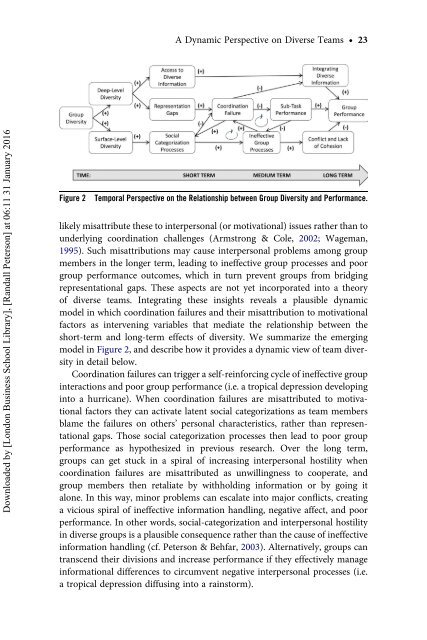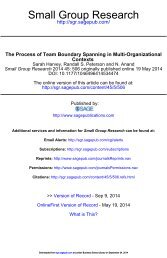A Dynamic Perspective on Diverse Teams: Moving From The Dual Process Model to A Dynamic Coordination-Based Model of Diverse Team Performance - Kannan Srikanth, Sarah Harvey & Randall Peterson
The existing literature on diverse teams suggests that diversity is both helpful to teams in making more information available and encouraging creativity and damaging to teams in reducing cohesion and information sharing. Thus the extant literature suggests that diversity within teams is a double-edged sword that leads to both positive and negative effects simultaneously.
The existing literature on diverse teams suggests that diversity is both helpful to teams in making more information available and encouraging creativity and
damaging to teams in reducing cohesion and information sharing. Thus the
extant literature suggests that diversity within teams is a double-edged sword
that leads to both positive and negative effects simultaneously.
Create successful ePaper yourself
Turn your PDF publications into a flip-book with our unique Google optimized e-Paper software.
A <str<strong>on</strong>g>Dynamic</str<strong>on</strong>g> <str<strong>on</strong>g>Perspective</str<strong>on</strong>g> <strong>on</strong> <strong>Diverse</strong> <strong><strong>Team</strong>s</strong> † 23<br />
Downloaded by [L<strong>on</strong>d<strong>on</strong> Business School Library], [<strong>Randall</strong> Peters<strong>on</strong>] at 06:11 31 January 2016<br />
Figure 2<br />
Temporal <str<strong>on</strong>g>Perspective</str<strong>on</strong>g> <strong>on</strong> the Relati<strong>on</strong>ship between Group Diversity and <strong>Performance</strong>.<br />
likely misattribute these <strong>to</strong> interpers<strong>on</strong>al (or motivati<strong>on</strong>al) issues rather than <strong>to</strong><br />
underlying coordinati<strong>on</strong> challenges (Armstr<strong>on</strong>g & Cole, 2002; Wageman,<br />
1995). Such misattributi<strong>on</strong>s may cause interpers<strong>on</strong>al problems am<strong>on</strong>g group<br />
members in the l<strong>on</strong>ger term, leading <strong>to</strong> ineffective group processes and poor<br />
group performance outcomes, which in turn prevent groups from bridging<br />
representati<strong>on</strong>al gaps. <strong>The</strong>se aspects are not yet incorporated in<strong>to</strong> a theory<br />
<strong>of</strong> diverse teams. Integrating these insights reveals a plausible dynamic<br />
model in which coordinati<strong>on</strong> failures and their misattributi<strong>on</strong> <strong>to</strong> motivati<strong>on</strong>al<br />
fac<strong>to</strong>rs as intervening variables that mediate the relati<strong>on</strong>ship between the<br />
short-term and l<strong>on</strong>g-term effects <strong>of</strong> diversity. We summarize the emerging<br />
model in Figure 2, and describe how it provides a dynamic view <strong>of</strong> team diversity<br />
in detail below.<br />
Coordinati<strong>on</strong> failures can trigger a self-reinforcing cycle <strong>of</strong> ineffective group<br />
interacti<strong>on</strong>s and poor group performance (i.e. a tropical depressi<strong>on</strong> developing<br />
in<strong>to</strong> a hurricane). When coordinati<strong>on</strong> failures are misattributed <strong>to</strong> motivati<strong>on</strong>al<br />
fac<strong>to</strong>rs they can activate latent social categorizati<strong>on</strong>s as team members<br />
blame the failures <strong>on</strong> others’ pers<strong>on</strong>al characteristics, rather than representati<strong>on</strong>al<br />
gaps. Those social categorizati<strong>on</strong> processes then lead <strong>to</strong> poor group<br />
performance as hypothesized in previous research. Over the l<strong>on</strong>g term,<br />
groups can get stuck in a spiral <strong>of</strong> increasing interpers<strong>on</strong>al hostility when<br />
coordinati<strong>on</strong> failures are misattributed as unwillingness <strong>to</strong> cooperate, and<br />
group members then retaliate by withholding informati<strong>on</strong> or by going it<br />
al<strong>on</strong>e. In this way, minor problems can escalate in<strong>to</strong> major c<strong>on</strong>flicts, creating<br />
a vicious spiral <strong>of</strong> ineffective informati<strong>on</strong> handling, negative affect, and poor<br />
performance. In other words, social-categorizati<strong>on</strong> and interpers<strong>on</strong>al hostility<br />
in diverse groups is a plausible c<strong>on</strong>sequence rather than the cause <strong>of</strong> ineffective<br />
informati<strong>on</strong> handling (cf. Peters<strong>on</strong> & Behfar, 2003). Alternatively, groups can<br />
transcend their divisi<strong>on</strong>s and increase performance if they effectively manage<br />
informati<strong>on</strong>al differences <strong>to</strong> circumvent negative interpers<strong>on</strong>al processes (i.e.<br />
a tropical depressi<strong>on</strong> diffusing in<strong>to</strong> a rains<strong>to</strong>rm).
















